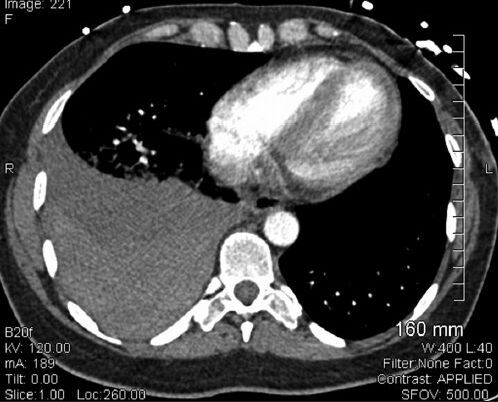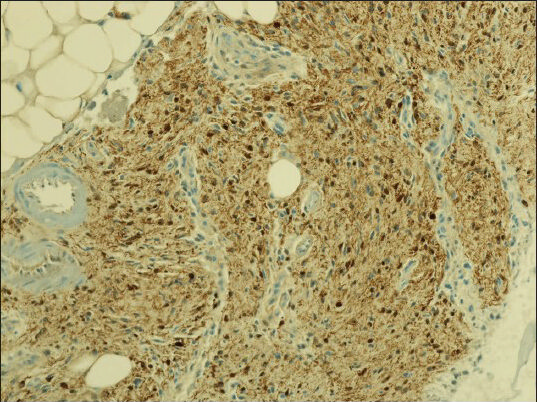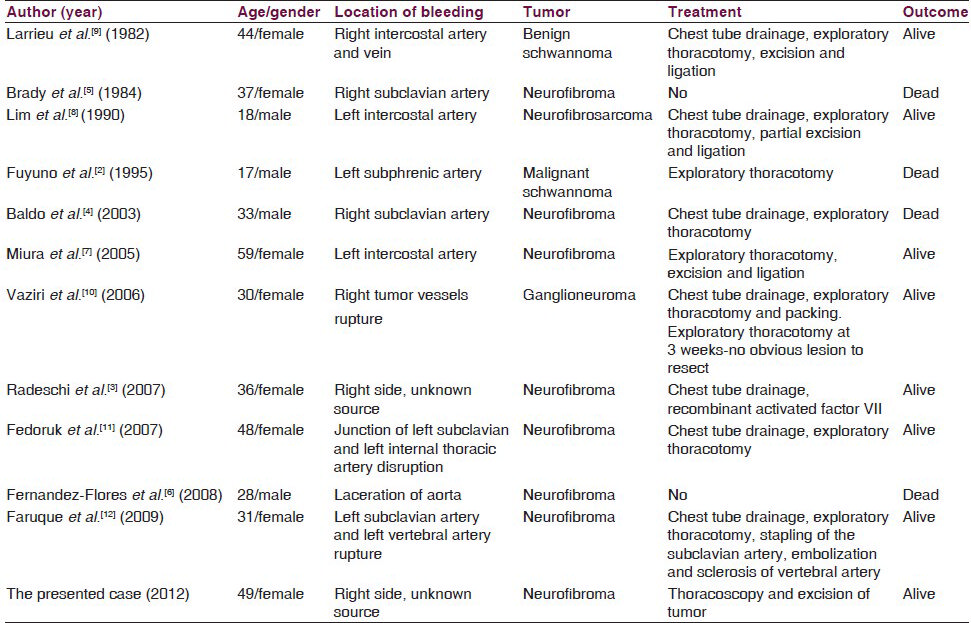Translate this page into:
Spontaneous hemothorax associated with neurofibromatosis type I: A review of the literature
This is an open-access article distributed under the terms of the Creative Commons Attribution-Noncommercial-Share Alike 3.0 Unported, which permits unrestricted use, distribution, and reproduction in any medium, provided the original work is properly cited.
This article was originally published by Medknow Publications & Media Pvt Ltd and was migrated to Scientific Scholar after the change of Publisher.
Abstract
Neurofibromatosis is generally a benign disease, but has the potential for rare and fatal complications, such as spontaneous hemothorax. We report a case of massive hemothorax due to neurofibroma in a 49-year-old woman with neurofibromatosis type 1. The configuration of the radiological opacity and frank blood withdrawn on thoracentesis should suggest the diagnosis of hemothorax in a patient with neurofibromatosis. Surgical treatment for hemothorax is limited by arterial fragility and the prognosis is relatively poor. Any evidence of aneurysmal disease in the thoracic vessels should be aggressively managed percutaneously by coil embolization to prevent future rupture.
Keywords
Neurofibroma
neurofibromatosis type I
spontaneous hemothorax
Introduction
Neurofibromatosis type I (NF-I) also known as Von Recklinghausen's disease, is an autosomal dominant disorder that involves abnormal growth of neuroectodermal tumors in the peripheral nervous system. The incidence of NF-I is one in 3000 individuals. NF-I is due to mutations in the neurofibromin-encoding gene that is located on chromosome 17q11.2 with characteristic variable penetration.[1] These mutations lead to the formation of neurofibromas of the peripheral nervous system with 50% of cases resulting from spontaneous mutations.[1] Spontaneous hemothorax is one of the uncommon complications of NF-I and is potentially fatal. The expected mediastinal tumor in Von Recklinghausen's disease is a tumor of nerve sheath origin, namely, neurofibroma, and 4% of patients with this disease develop malignant schwannoma, which has been reported to cause massive hemothorax.[2] We are describing a case of spontaneous hemothorax due to neurofibroma in a patient with a history of NF-I.
Case Report
A 49-year-old woman with a history of asthma, NF-I, and chronic smoking presented to the emergency room with chest pain. It was sudden onset of sharp, continuous pain in the right upper chest and radiating to the right lower chest, moderate in intensity, exacerbated with inspiration and cough. Her family history was positive for NF-1. Physical examination revealed the presence of decreased breath sounds at the base of the right lung. She had neurofibromas all over the skin. Computed tomography of the chest confirmed the presence of a large amount of right pleural effusion with mediastinal shift [Figure 1].

- Computed tomography of chest showing large amount of right pleural effusion and mediastinal shift to the left
Thoracentesis was done without successful drainage. Her hemoglobin dropped gradually from 11.2 mg/dL to 9.6 mg/dL. She underwent right thoracoscopy with evacuation of 2700 mL of blood. During the procedure, an apical mass with sentinel clot was demonstrated. The frozen section reported the absence of malignancy. We were unable to find the exact source of bleeding. Histology showed the segments of hyperplastic nerve tissue, consisting of cells that were S-100-positive by immunohistochemistry, confirming the diagnosis of neurofibroma [Figure 2]. The patient improved after surgery and she was discharged to home in stable condition.

- Histology section showing the segments of hyperplastic nerve tissue consisting of cells that are S-100 (+) by immunohistochemistry
Discussion
Spontaneous hemothorax is a rare and often lethal complication of NF-I. Two different types of vasculopathy have been described: Stenosis or aneurysmal modifications of large intrathoracic vessels, most commonly the subclavian artery and the intercostal arteries; and dysplastic alterations of small vessels in highly vascularized mesenchymal tumors.[3] Most commonly, tumor-related hemothorax is due to neurofibroma, and the most frequently involved artery is the intercostal artery.
Of the 11 published studies as shown in Table 1, nine patients underwent surgical exploration with two postoperative deaths.[24] However, the sudden death without operation was also reported in two patients with NF-1.[56] Sudden death occurred in a patient with spontaneous hemothorax due to neurofibroma causing a compression fracture of the thoracic vertebrae that in turn led to laceration of the aorta.[6] In another case report, immediate death following spontaneous hemothorax during the postpartum period in a 37-year-old female with history of NF-I, due to rupture of right subclavian artery by infiltrating neurofibromas.[5] In a review article by Miura et al., in 2005, of seven patients with spontaneous hemothorax, the histology of tumors included five benign tumors (one benign schwannoma and four neurofibromas) and two malignant tumors (one malignant schwannoma and one neurofibrosarcoma).[7]

In the case report described by Lim et al., an 18-year-old male had partial excision of a large hemorrhagic mediastinal tumor and it was diagnosed as neurofibrosarcoma.[8] Another case presented with spontaneous hemothorax due to mediastinal tumor was also managed with excision and it was a benign schwannoma.[9] Vaziri et al. managed their patient with exploratory thoracotomy, which showed continuous bleeding from tumor vessels (confirmed as ganglioneuroma), and they were unable to achieve a stable hemodynamic status despite the transfusion of eight units of blood and they packed the area with three large laparotomy pads.[10] Three weeks later an uneventful re-thoracotomy showed the disappearance of the tumor perhaps due to the rupture and losing its vascular supply leading to necrosis or degeneration.[10] The patient has been followed for two years without any complications.
In another case reported by Fedoruk et al., there was disruption of the left subclavian artery and left internal thoracic artery junction, and exploratory thoracotomy revealed tissue masses and clots.[11] As these vessels were friable and brittle, multiple attempts at a primary suture repair were made, and the artery was over sewn. Faruque et al. described a patient with neurofibromatosis who developed massive hemothorax as a result of spontaneous rupture of the left vertebral artery and left subclavian artery due to invasion by neurofibromas.[12] They successfully managed the patient with a combination of surgical and interventional radiology techniques, stapling of the left subclavian artery and endovascular embolization of left vertebral artery.
Another patient presented with spontaneous hemothorax due to an unknown source of bleeding as observed in our case, managed with recombinant-activated VII factor (Novoseven 90 μ/kg) after an unsuccessful surgical attempt to stop bleeding.[3] The patient's bleeding was well controlled after the infusion of recombinant-activated VII factor for three times.
Conclusion
We emphasize the importance of consideration of spontaneous hemothorax and mediastinal tumor in the differential diagnosis in any patient with a history of neurofibromatosis type I, who presents with chest pain and pleural effusion. Early diagnosis and intervention is critical to prevent mortality. Spontaneous massive hemothorax in a patient with neurofibromatosis type I is due to erosion of thoracic vessels by tumor or from degeneration of a hypervascular neural tumor.
Source of Support: Nil.
Conflict of Interest: None declared.
References
- A case of Von Recklinghausen's disease associated with a hemothorax due to a rapidly growing malignant schwannoma. Nihon Kyobu Shikkan Gakkai Zasshi. 1995;33:682-5.
- [Google Scholar]
- Utilization of recombinant activated factor VII in a case of spontaneous massive haemothorax in a patient with Von Recklinghausen's disease. Minerva Anestesiol. 2007;73:241-4.
- [Google Scholar]
- Fatal right spontaneous haemothorax in Von Recklinghausen's disease. Interact Cardiovasc Thorac Surg. 2003;2:35-7.
- [Google Scholar]
- Neurofibromatosis and spontaneous hemothorax in pregnancy: Two case reports. Obstet Gynecol. 1984;63(Suppl 3):35S-8S.
- [Google Scholar]
- Café-au-lait macules: Occasional fatal sequels of benign pigmented lesions. Acta Dermatovenerol Croat. 2008;16:79-82.
- [Google Scholar]
- Spontaneous hemothorax in patients with von Recklinghausen's disease. Jpn J Thorac Cardiovasc Surg. 2005;53:649-52.
- [Google Scholar]
- Neurofibrosarcoma presenting as spontaneous haemothorax. Br J Clin Pract. 1990;44:289-91.
- [Google Scholar]
- Spontaneous massive haemothorax in von Recklinghausen's disease. Thorax. 1982;37:151-2.
- [Google Scholar]
- Massive spontaneous hemothorax associated with Von Recklinghausen's disease. Ann Thorac Surg. 2006;82:1500-1.
- [Google Scholar]
- Spontaneous hemothorax and neurofibromatosis: A review of a lethal combination. Asian Cardiovasc Thorac Ann. 2007;15:342-4.
- [Google Scholar]
- Clinical challenges and serious vascular complications in neurofibromatosis. Emerg Med Australas. 2009;21:518-20.
- [Google Scholar]






